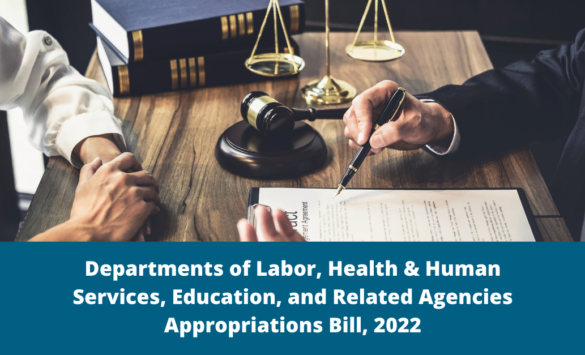In recent months, there have been several articles either directly addressing or alluding to the fact a United States House Committee on Appropriations recommended spending a sizeable amount of money monitoring state workers’ compensation systems. The clear impression these articles create is the Federal Government is very concerned about workers’ compensation benefit adequacy and the treatment of injured workers in state workers’ compensation systems. What does this mean for the workers’ compensation industry?
In a discussion on Federal intrusion a few weeks ago, it became clear the articles I read did not clarify what was being proposed. Was big brother in fact going to scrutinize the way states operate their workers’ compensation systems or is there something else being recommended? One way to answer this question is to read the source of the proposal to see what the Committee said and analyze what is being proposed.
In a report dated July 19th, 2021, The House Committee on Appropriations provides details on spending recommendations for the Department of Labor, Health and Human Services, Education, and related agencies.[i] The report is lengthy, more than 500 pages, and provides estimates and appropriation recommendations for various federal agencies.
There is a section concerning the Office of Workers Compensation Programs presented early in the report. We learn what the appropriation was for fiscal year 2021, the budget request for fiscal year 2022, and the committee’s funding recommendations. In the narrative explaining the reason for their funding recommendations, the Committee shares a concern on page 31 of the report about the “ongoing and systematic decline in the adequacy of benefits provided to injured workers under the State-based workers compensation systems.”[ii] The committee observes the costs for disabling workplace injuries are being shifted away from State workers’ compensation systems to Federal benefit programs. If the report or the explanation was to end there, one could get the impression State systems were uniformly not fulfilling their statutory obligations to protect injured workers. It could be read to suggest the State systems failing those obligations. Importantly, however, the committee observes further, “With the growth of the gig economy and misclassification of workers as independent contractors, millions of workers are falling through the cracks in State workers’ compensation systems. Given the impact on the Federal government, the Committee believes State workers’ compensation programs should be monitored on an ongoing basis.”
The committee report reminds us that following the Report of The National Commission on State Workers Compensation Laws in 1972, State systems were the subject of an annual Federal review until 2004, when monitoring the States was discontinued.
So, should State workers’ compensation systems be concerned about this federal oversight? I think not. Employee misclassification is a perennial problem for all workers’ compensation systems. Some aspects of the gig economy feed into this problem. Would state regulators welcome a misclassification solution? I think so. In addition, others within the broader workers’ compensation community would welcome having adequate coverage for injured workers. Lawyers representing injured workers would of course want to have their clients adequately and fully protected. Employers who do things correctly and protect their employees want to see others in the labor force appropriately protected. Finally, workers in our economy who are unaware of their status as an independent contractor leaves them unprotected if they find themselves injured, would also have protection.
The recommendation to reinstate a state monitoring system to address the problems posed by some in the gig economy for all who are misclassified, should not be a concern for those within the workers’ compensation community, because helping to solve this problem benefits all who are doing things correctly and prioritizing the best interest of the injured worker.
Notes
[i] 117th CONGRESS REPORT 1st Session. HOUSE OF REPRESENTATIVES REPORT 117-96. DEPARTMENTS OF LABOR, HEALTH AND HUMAN SERVICES, AND EDUCATION, AND RELATED AGENCIES APPROPRIATIONS BILL, 2022. U.S. Government Publishing Office. https://www.congress.gov/117/crpt/hrpt96/CRPT-117hrpt96.pdf.
[ii] 17th CONGRESS REPORT 1st Session. HOUSE OF REPRESENTATIVES REPORT 117-96. DEPARTMENTS OF LABOR, HEALTH AND HUMAN SERVICES, AND EDUCATION, AND RELATED AGENCIES APPROPRIATIONS BILL, 2022. U.S. Government Publishing Office. https://www.congress.gov/117/crpt/hrpt96/CRPT-117hrpt96.pdf. Page 31.


